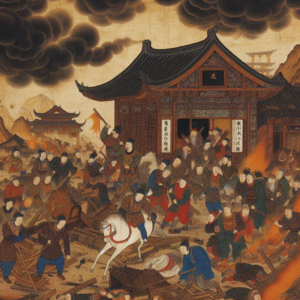Pogrom of the Caphirians: Difference between revisions
mNo edit summary Tag: 2017 source edit |
mNo edit summary Tag: 2017 source edit |
||
| Line 20: | Line 20: | ||
The '''Pogrom of the Caphirians''' also known as the '''Rakin Pogrom''' was a pogrom that took place in [[Daxia|Qian]] controlled [[Rakin]], [[Peratra]] in August of 1758. The attack originally targeted wealthy [[Caphiria]]ns residing on the port city but eventually extended to other inhabitants of foreign origin. The pogrom was carried out by large mobs of [[Daxia]]ns and their Polynesian slaves over approximately five hours before the authorities managed to disperse the throngs by force; during this time at least 1,500 [[Caphiria]]ns and other foreigners were killed in their homes and on the streets while another 3,500 were wounded with knifes or bludgeoned with clubs. Accounts on what exactly started the massacre differ greatly, according to some witness statements the riot began when a wealthy Caphirian slave trader named as Baldogilo Serentesi whipped his [[Daxia]]n maid in front of his house before ripping apart her dress whereupon an incensed mob set upon him with sticks and rocks, killing him. Afterwards the mob began to burn Serentesi's manor and all other adjacent houses in the Caphirian Quarter while also attacking other non-Daxians they came across; the violence escalated into a city-wide riot. | The '''Pogrom of the Caphirians''' also known as the '''Rakin Pogrom''' was a pogrom that took place in [[Daxia|Qian]] controlled [[Rakin]], [[Peratra]] in August of 1758. The attack originally targeted wealthy [[Caphiria]]ns residing on the port city but eventually extended to other inhabitants of foreign origin. The pogrom was carried out by large mobs of [[Daxia]]ns and their Polynesian slaves over approximately five hours before the authorities managed to disperse the throngs by force; during this time at least 1,500 [[Caphiria]]ns and other foreigners were killed in their homes and on the streets while another 3,500 were wounded with knifes or bludgeoned with clubs. Accounts on what exactly started the massacre differ greatly, according to some witness statements the riot began when a wealthy Caphirian slave trader named as Baldogilo Serentesi whipped his [[Daxia]]n maid in front of his house before ripping apart her dress whereupon an incensed mob set upon him with sticks and rocks, killing him. Afterwards the mob began to burn Serentesi's manor and all other adjacent houses in the Caphirian Quarter while also attacking other non-Daxians they came across; the violence escalated into a city-wide riot. | ||
==Background== | ==Background== | ||
The beginning of trading by the [[Daxia|Qian dynasty]] with [[Sarpedon]] by way of the [[Southern Route|Southern route]] brought the Daxian people into regular contact with 'civilized western' foreigners outside of naval action and slavery. Exchanges with the [[Caphiria|Third Imperium]] and the [[Carto-Pelaxian Commonwealth]] proved so profitable that certain aspects of the long held [[Daxian Racialism]] espoused in [[Zhangwo]] ideology were quietly loosened. Regulations on foreigners living on Qian-controlled [[Peratra]] were adjusted to be less restrictive and this caused an influx of traders and businessmen of all stripes choosing to settle in various ports. Cities like [[Port Bondor]], [[Rakin | The beginning of trading by the [[Daxia|Qian dynasty]] with [[Sarpedon]] by way of the [[Southern Route|Southern route]] brought the Daxian people into regular contact with 'civilized western' foreigners outside of naval action and slavery. Exchanges with the [[Caphiria|Third Imperium]] and the [[Carto-Pelaxian Commonwealth]] proved so profitable that certain aspects of the long held [[Daxian Racialism]] espoused in [[Zhangwo]] ideology were quietly loosened. Regulations on foreigners living on Qian-controlled [[Peratra]] were adjusted to be less restrictive and this caused an influx of traders and businessmen of all stripes choosing to settle in various ports. Cities like [[Port Bondor]], [[Rakahanga|Rakin]] and [[Yishi]] developed their own foreign quarters in time. | ||
==Pogrom== | ==Pogrom== | ||
==Aftermath== | ==Aftermath== | ||
Revision as of 02:47, 29 May 2024
| Pogrom of the Caphirians | |
|---|---|
 | |
| Location | Rakin, Qian controlled Peratra |
| Date | August 1758 |
| Target | Caphirians, other foreigners |
Attack type | Daxian racialist reaction |
| Deaths | 1,500 |
| Injured | 3,500 |
| Perpetrators | Daxia |
The Pogrom of the Caphirians also known as the Rakin Pogrom was a pogrom that took place in Qian controlled Rakin, Peratra in August of 1758. The attack originally targeted wealthy Caphirians residing on the port city but eventually extended to other inhabitants of foreign origin. The pogrom was carried out by large mobs of Daxians and their Polynesian slaves over approximately five hours before the authorities managed to disperse the throngs by force; during this time at least 1,500 Caphirians and other foreigners were killed in their homes and on the streets while another 3,500 were wounded with knifes or bludgeoned with clubs. Accounts on what exactly started the massacre differ greatly, according to some witness statements the riot began when a wealthy Caphirian slave trader named as Baldogilo Serentesi whipped his Daxian maid in front of his house before ripping apart her dress whereupon an incensed mob set upon him with sticks and rocks, killing him. Afterwards the mob began to burn Serentesi's manor and all other adjacent houses in the Caphirian Quarter while also attacking other non-Daxians they came across; the violence escalated into a city-wide riot.
Background
The beginning of trading by the Qian dynasty with Sarpedon by way of the Southern route brought the Daxian people into regular contact with 'civilized western' foreigners outside of naval action and slavery. Exchanges with the Third Imperium and the Carto-Pelaxian Commonwealth proved so profitable that certain aspects of the long held Daxian Racialism espoused in Zhangwo ideology were quietly loosened. Regulations on foreigners living on Qian-controlled Peratra were adjusted to be less restrictive and this caused an influx of traders and businessmen of all stripes choosing to settle in various ports. Cities like Port Bondor, Rakin and Yishi developed their own foreign quarters in time.